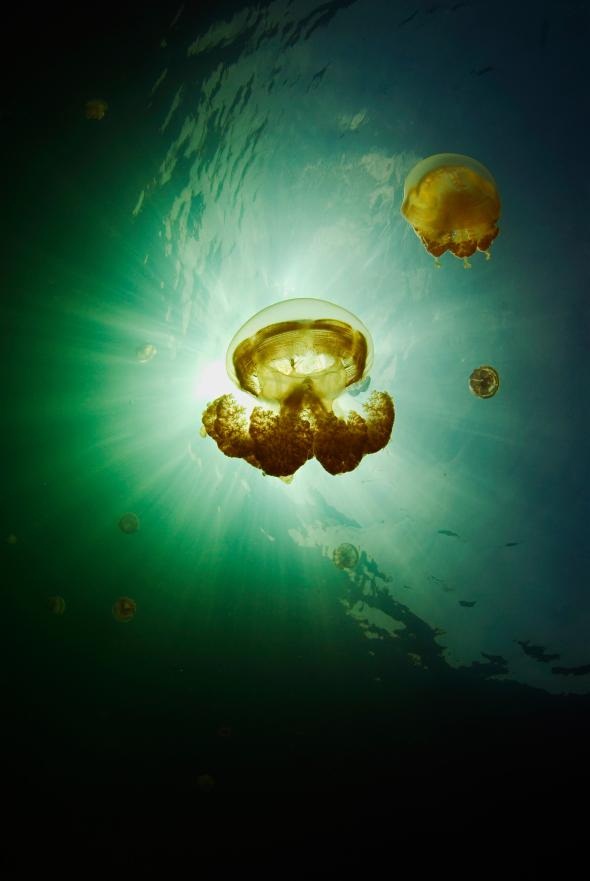The Famous Jellyfish Lake Is Running Out of Jellyfish Palau’s unique golden jellyfish are probably being hammered by drought and El Niño.

Swimming with golden jellyfish swarms in a saltwater lake in Palau has long been on the bucket lists of adventurous travelers. But that singular experience may be in jeopardy, scientists warn, as these famous jellyfish have all but disappeared. The jellies likely live on attached to the lake bottom as polyps, an early phase in the jellyfish life cycle. If so, scientists are hopeful that once conditions in the lake improve, a new generation will again produce the free swimming adult medusa that so delight tourists. But other experts warn that the long-term future of the lake's unique ecosystem may be at risk due to climate change. What's more, while the jellyfish are a highly visible part of the ecosystem, they may be responding to subtle changes that are less well known. "They may simply be the tip of the iceberg," says National Geographic explorer David Gruber, a marine biologist at Baruch College, City University of New York and the American Museum of Natural History.
Crashing Jellies
Jellyfish Lake on Eil Malk Island in the western Pacific country of Palau is part of a World Heritage Site thanks to its stunning natural beauty and unique environment, which includes coral reefs and high biodiversity. The area is home to several marine lakes, each holding what may be its own species of golden jellyfish. Jellyfish Lake is the most famous of the bunch, and it is also known for the fact that below about 40 feet (13 meters), the water has a high concentration of toxic hydrogen sulfide. This makes it dangerous for scuba diving, which is why only snorkeling is allowed in the lake. In March, the California and Palau-based Coral Reef Research Foundation estimated the lake's jelly population at 600,000, down from an average of eight million. Since then, the population has been "on the verge of crashing," the group warns. Over the past few weeks, tourists have failed to find any adult jellyfish in the lake, causing some tour companies to cancel their operations.
Salty Situation
Scientists aren't sure exactly why the jellies have disappeared, but Koror State Governor Yositaka Adachi has blamed drought spurred by the ocean-warming effects of El Niño. Rainfall in the area over the past four months has been the lowest in 65 years, he noted in a statement. And according to the Coral Reef Research Foundation, the lake is now saltier than ever recorded due to the lack of rain. "It's difficult to tease out what is happening in the lake," says Gruber. "Is it natural fluctuation or climate change? This highlights why we need long-term monitoring of places, so we can understand these systems more." Gruber adds that it's also an unusual situation, because people often consider jellyfish stinging pests, and some species can even be fatal. With the decline of many other marine groups from overfishing and pollution, hardy jellyfish have often multiplied, raising fears of jelly blooms near coastal regions. "People fear a zombie ocean filled with nothing else but jellyfish, but in this case they live in a tourist area and people are attached to them," says Gruber.
Possible Comeback
The golden jellyfish are known for following a daily migration through the lake, tracking the sun's march across the sky. Solar rays nourish essential, algae-like organisms called zooxanthellae, which live symbiotically in the jellies’ tissues and provide their hosts with energy as a byproduct of their photosynthesis. For now, it's unclear when that migration may return to the region. Jellyfish in the lake also crashed in the late 1990s, likely due to El Niño, but they recovered afterward from the surviving polyps. This time around, observers are again hopeful that there will be enough polyps to ensure the population could eventually recover. "They came back before, so we'll see what happens this time," says Enric Sala, a National Geographic Explorer-in-Residence who led a Pristine Seas expedition to Palau a few years ago.
Read More: http://news.nationalgeographic.com/2016/05/160504-golden-jellyfish-disappear-from-palau-lake/

